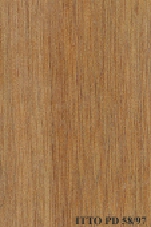
VIROLA (Virola flexuosa)
Trade Name
Virola
Scientific Name
Virola flexuosa A.C. Sm.
Family
MYRISTICACEAE
Common Names
Moulomba (Guyana); Cumala (Peru); Pintri (Surinam); Cajuea (Trinidad & Tobago); Otivo (Venezuela); Virola (Venezuela); Cuajo (Venezuela); Camaticaro (Venezuela); Nuanamo (Colombia); Sangrino (Venezuela); Cumala Colorada (Peru); Banak; Dalli (Guyana); Tapsava; Virola (Brazil); Ucuhuba (Brazil); Yayamadou (Guyana); Bicuiba Branca (Brazil); Shempo (Ecuador); Sangre; Chaliviande (Ecuador); Cumala Blanca (Peru); Palo De Sangre; Colorado; Ucuuba (Brazil); Sebo (Colombia); Baboen (Surinam); Birma; Virola; Virola Amarilla (Peru); Ocopi`jin (Ecuador); Omando (Ecuador); Unay (Ecuador); Tirasucio (Colombia); Sota negra (Colombia); Sota (Colombia)
Description Of The Tree
Botanical Description
The tree is reported to be middle to big sized, with small buttresses.
Natural Distribution
V. flexuosa is found from Colombia and Ecuador, down to Brazil and Peru. In Colombia it is reported in the Magdalena valley.
Wood Identification
Anatomic Description Of Wood
Wood diffuse porous. Vessels solitary and in short radial multiples. Tangential diameter of vessel lumina 150 to 200 micras (medium). Vessels per mm2 10 to 20 (abundant). Simple perforation plates. Occasionally multiple perforation plates. Vessel-ray pits coars Occasionally axial parenchyma in marginal or in seemingly marginal bands. 4 to 10 rays per mm (medium). Rays commonly 2 seriate. Heterogeneous rays and/or multiseriate heterogeneous rays. Body ray cells procumbent with over 4 rows of upright and/or square marginal cells (Kribs-I). Fibers with simple to minutely bordered pits.
-
 Wood Macro Photo Tangential Plane
Wood Macro Photo Tangential Plane
Availability
Cites Status
Unrestricted
General Wood Description
Odor
It has no distinct odor or taste.
Color
The sapwood is not differentiated, the heartwood is pale brown.
COLOR INDEX (1=Black, 7=Light yellow,white)
4
Grain
The grain is mostly straight
Texture
The wood is typically medium in texture.
Luster
Luster is moderate to high.
Natural Durability
It is easily attacked by fungi or termites. It is reported to be also attacked by Lyctus.
Natural durability index (1= Very high durability, 7=Vey low durability)
5
Resistance To Impregnation
This species is reported to be easy to preserve.
Wood Physical Properties
Basic Density or Specific Gravity (O.D. weight/vol. green) (g/cm³)
0.49
Air-dry Density (Weight and volume at 12%MC) (g/cm³)
0.53
Total shrinkage Tangential (Saturated to 0%MC) (%)
9.8
Total shrinkage Radial (Saturated to 0%MC) (%)
5.4
Drying Defects
Ease of Drying: It is relatively easy to air season. Drying Defects: Slight checking and moderate warping.
Recommended Dry Kiln Schedule
UK-C; US-T3-C2
Dimensional stability ratio (Total Tangential Shrinkage %/Total Radial Shrinkage %)
1.8
Wood Chemical Properties
Wood Mechanical Properties
Bending Strength (MOR),12%MC (kgf/cm²)
581
Stiffness (MOE) 12%MC (kgf/cm²)
105059
Compression parallel to fiber 12%MC (kgf/cm²)
377
Workability
Sawing
Sawmilling of this species is reportedly easy.
Rotary Veneer Cutting
Lamination of this species is possible.
Sliced Veneer
Lamination of this species is possible.
Machining
Machining operations are rather easy.
Planing
Planing of this species is reported to be easy.
Moulding
Molding operations are rather easy.
Boring
Boring operations are rather easy.
Sanding
Wood of this species is easy to sand.
Finishing
It is easy to finish.
Response To Hand Tools
This species is reported to be easy to work with hand tools.
REFERENCED USES
End Uses Summary
HOUSING GENERAL, fittings, PLYWOOD AND VENEER
General Housing
- 10 - Silica in Timbers
Fittings
- 19 - Silica in Timbers
Panels, Veneers
- 25 - Directory of Timber Trade Malaysia
Please Provide Information To View Producer Information